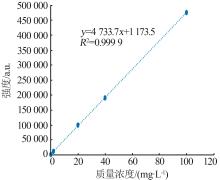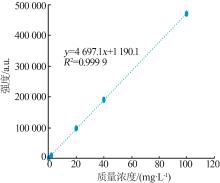| [1] |
CHEN Can, CAO Jun, ZHANG Yongbo.
Research on high throughput determination method of fluorine and leaching toxicity in aluminum ash
[J]. Inorganic Chemicals Industry, 2024, 56(8): 104-109.
|
| [2] |
WANG Benlei, ZHANG Guisheng, JIANG Lingyun, LI Chen, WANG Pengfei, LI Jixia, ZANG Jiazhong.
Study on preparation process of rhodium trichloride by roasting recovery technology from waste rhodium solution of carbonyl synthesis
[J]. Inorganic Chemicals Industry, 2023, 55(6): 104-108.
|
| [3] |
WANG Ping.
Quantitative analysis of linkage between lithium supply and demand and lithium price
[J]. Inorganic Chemicals Industry, 2022, 54(9): 1-13.
|
| [4] |
LEI Ming,ZHU Hanyu,LIU Zilong,CHEN Guopeng,YUAN Junsheng.
Distribution and speciation of heavy metals in hardened solid of net slurry co?disposed by cement kiln
[J]. Inorganic Chemicals Industry, 2022, 54(8): 107-113.
|
| [5] |
LI Yajiao,ZHAO Yiwei,JU Kai,TANG Renlong,LI Longqing,SHAO Xiaoping,ZHANG Gaofeng,REN Wuang.
Study on optimization of extraction conditions in process of determination of ammonia content in fly ash based on response surface method
[J]. Inorganic Chemicals Industry, 2022, 54(4): 145-151.
|
| [6] |
Wang Pengfei,Jiang Lingyun,Li Chen,Li Jixia,Hao Tingting,Wang Benlei,Zang Jiazhong,Wu Qing.
Stndy on preparation and industrial side line experiment of catalyst in synthesis of butyl octanol
[J]. Inorganic Chemicals Industry, 2021, 53(5): 105-110.
|
| [7] |
He Xiaoying,Li Chen,Wang Pengfei,Jiang Lingyun,Zang Jiazhong,Wu Qing.
Study on enrichment process of rhodium from rhodium containing solution by sodium sulfide precipitation
[J]. Inorganic Chemicals Industry, 2021, 53(4): 81-85.
|
| [8] |
Wang Pengfei,Hu Yuanming,Li Chen,Zhang Baoguo,Wang Benlei,Li Jixia,Jiang Lingyun,Zang Jiazhong.
Study on hydroformylation of 1-decene catalyzed by homogeneous rhodium phosphine
[J]. Inorganic Chemicals Industry, 2021, 53(3): 102-105.
|
| [9] |
Zheng Na,Zhou Junhong,Chen Hangxin,Chen Shengyue,Wan Zongjing,Sheng Yu.
Study on a new method for determination of hypophosphorous acid
[J]. Inorganic Chemicals Industry, 2021, 53(10): 114-118.
|
| [10] |
Liao Xiaoting,Li Jun,Chen Ming.
Process study on preparation of industrial grade ammonium dihydrogen phosphate from urea phosphate mother liquor
[J]. Inorganic Chemicals Industry, 2020, 52(4): 79-83.
|
| [11] |
Zhou Xiumei,Sun Guixing.
Optimization technology for stable operation of ammonium chloride crystal system in potassium dihydrogen phosphate production plant
[J]. Inorganic Chemicals Industry, 2019, 51(12): 58-60.
|
| [12] |
CAI Zhuang-Hong, HE Su-Jiao.
Study on continuous preparation of potassium ferrate by electrolytic process
[J]. INORGANICCHEMICALSINDUSTRY, 2016, 48(7): 51-.
|
| [13] |
JIANG Ling-Yun, YU Hai-Bin, LI Chen, LI Ji-Xia, HAO Ting-Ting, WANG Peng-Fei.
Study on rhodium recovery process by roasting rhodium
containing waste catalyst from butyl octanol unit
[J]. INORGANICCHEMICALSINDUSTRY, 2015, 47(4): 51-.
|
| [14] |
YU Xiao-Wei, FU Chun-Ming, ZHANG Xiao-Bo, ZHANG Chun-Li.
Improvement of determination of iron content in LiMn2O4 by ICP method
[J]. INORGANICCHEMICALSINDUSTRY, 2014, 46(4): 67-.
|
| [15] |
WU Gui-Ling, ZHOU Jun-Hong, LU Yu-Lian, YOU Cai-Xia, SUN Cheng-Bin, XING , YAN , LIU Pin-Zhen.
Hydrolysis and content measurement of sodium tripolyphosphate by titration method
[J]. INORGANICCHEMICALSINDUSTRY, 2014, 46(2): 47-.
|
 ), LI Jixia2(
), LI Jixia2( ), ZHANG Guisheng1, WANG Pengfei2, WANG Benlei2
), ZHANG Guisheng1, WANG Pengfei2, WANG Benlei2



